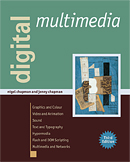
See the book at amazon.co.uk or amazon.com
Related Books

See Digital Multimedia at amazon.co.uk or amazon.com

See Web Design: A Complete Introduction at amazon.co.uk or amazon.com
The authors are not responsible for the content of any external sites linked to from digitalmediatools.org
All material on this site is ©2007–2010 MacAvon Media and may not be reproduced without permission.
Illustrator Hints and Tips
Cropping Artwork for Export
Illustrator is a little inconsistent about how much of the artboard it includes in an exported file. Often — for instance when you use Save for Web & Devices — your document is cropped to the bounding box of the artwork, but at other times — most notably when you save a PDF — the entire artboard is included in the exported file. You can specify exactly how much is exported by setting the crop area. This is most easily done with the Crop tool. You can drag out a rectangle with this tool, which defines the area to be included in any exported file. This area need not include all the objects in the document. Anything lying outside the crop area is omitted, anything that overlaps the edge of the crop area is cropped.
If you double-click the Crop tool you can set the position, dimensions and some other properties of the crop area explicitly. You can also choose from a lengthy list of presets, including cropping to the artboard, to the bounding box of all artwork or selected objects, and a host of values corresponding to common paper and screen sizes and frames in all video standards.
Unlike most other tools, you must confirm the effect of using the Crop tool by selecting a different tool after setting the crop area. There is no confirm or cancel button in the Control panel.
Use the Object>Crop Area>Release command to unset any crop area. Some Illustrator presets include a crop area, which you might not want.
Making Several Copies of an Object
Illustrator does not have the Step and Repeat command found in some other programs, such as InDesign, for making copies of an object arranged in a grid, but you can do the same job just as quickly in the following way. Select the object, choose Transform from the Effect>Distort & Transform sub-menu, set a vertical or horizontal offset in the appropriate box under Move, enter a number of copies and click OK. The number of copies you specify will appear, but since this is an effect, they are not really there. You can make them go away again by removing the effect. To turn them into real copies, though, all you need to do is select the original object and use the Object>Expand Appearance command.
If you want to create a rectangular grid of objects, apply the Transform effect with a vertical offset of zero and a non-zero horizontal offset to get an apparent row of objects, then apply a second instance of the effect with a non-zero vertical offset and a zero horizontal offset. You will then be able to expand the appearance of both effects at once to get your rectangular array of objects.
After expanding the appearance, the resulting objects are grouped. If you have used two instances of the effect, they are grouped into rows which are grouped into columns. Just ungroup or use the group selection tool in the usual way to get at the individual copies.
Anti-Aliasing and Web Graphics
When converting a vector image to a bitmap, anti-aliasing is usually advisable, because it results in smoother edges. However, sometimes anti-aliasing will have unwanted side-effects. In particular, if you are saving a GIF with its limited palette using Save for Web & Devices, anti-aliasing can result in white bands around the edges of the image, which can be disastrous. For instance, if you are saving a one pixel wide gradient to use as a background, anti-aliasing may cause the GIF to be two or three pixels wide, so that when you tile it as a background you end up with stripes instead of a smooth gradient. If something of this sort is happening, uncheck the Anti-Alias box which you can find in the Image Size tab in the Save for Web & Devices dialogue.
Precise Cursors
Ticking the checkbox labelled Use Precise Cursors in the General category of preferences causes the cursor to be displayed as a fine cross for most tools. The arrow tools and the Free Transform tool are not affected. The precise cursors allow you to draw and make selections more accurately by eye. There is some variation among the precise cursors: for instance, the pencil and pen tools' cursors are an x, whereas the shape tools' are + shaped. However, these cursor do not show you at a glance which tool you are using the way that the ordinary cursors do.